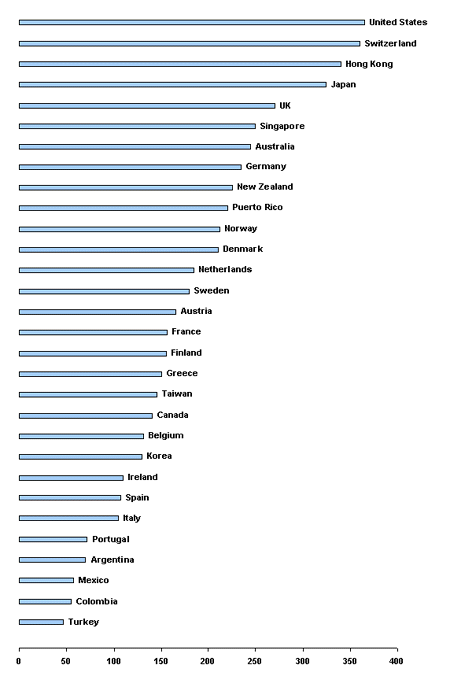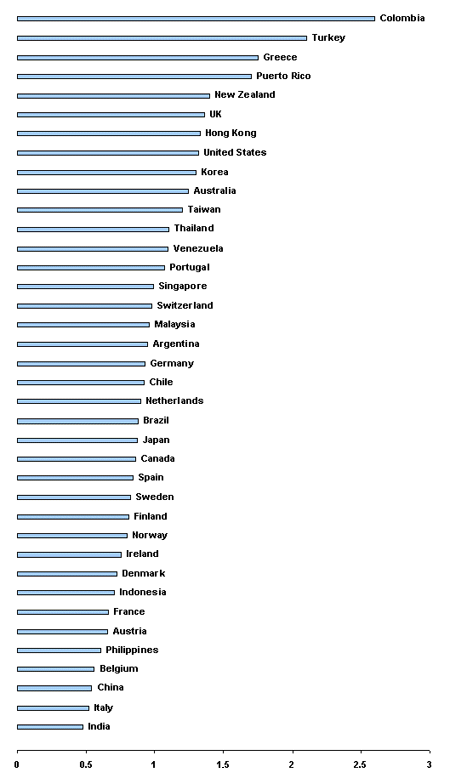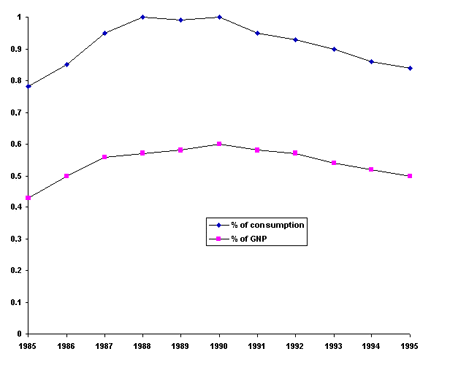
A few data on advertising in Italy and worldwide
Summarized and translated from chapter 15 of “Il nuovo libro della pubblicità”
by Luis Bassat and Giancarlo Livraghi - Il Sole 24 Ore Libri - May 1997
Sources for data: Media Key (April 1996); Zenit Media; Association des Agences Conseil en Communication.
In spite of the clutter, Italy is not one of the most developed countries in advertising and commercial communication.
At first glance, the total amount of advertising investments in Italy appears quite relevant - the seventh largest worldwide, as shown in this chart:
|
The first 15 countries by volume of advertising investment
Television, press, radio, cinema, outdoor (millions of US dollars- 1995) |
||
| % of world | ||
| United States | 95,192 | 36.5 |
| Japan | 38,900 | 14.9 |
| Germany | 18,891 | 7.2 |
| UK | 14,990 | 5.7 |
| France | 9,398 | 3.4 |
| Mexico | 5,872 | 2.2 |
| Italy | 5,730 | 2.2 |
| South Corea | 5,699 | 2.2 |
| Brazil | 4,503 | 1.7 |
| Australia | 4,259 | 1.6 |
| Spain | 4,258 | 1.6 |
| Canada | 4,180 | 1.6 |
| China | 3,566 | 1.4 |
| Taiwan | 3,162 | 1.2 |
| Netherlands | 2,961 | 1.1 |
| Note: this chart and the graphs that follow don’t include countries of the ex Soviet Union and Eastern Europe. These are missing from the databases used, probably because after the big changes in those areas there is not enough information for coherent historical analysis. |
The reliability of these comparisons is always limited, because of the complexity of calculations and the differences in the criteria used to measure investments in different countries; but in spite of these limitations the general pattern is reasonably well reflected in the data.
Even from this first analysis Italy’s position appears quite weak. If we consider that Italy’s economy in general is approximately 4 percent of the world’s, we see that advertising investments are half of what they should be to keep pace with the major competing economies.
Also, the fast growth of advertising in some countries (such as Korea, China, other Asian countries and possibly Brazil) indicates that soon Italy will be overtaken and step down to tenth position - or worse.
Italy’s weakness becomes more obvious in this analysis:
Per-capita investments
in US $ -1995

By per-capita investment, Italy is in 25th place - and slipping.
The picture looks even worse in relation to GNP. Italy is in 39th place and will certainly be lower in the next few years:
Advertising investments as % of GNP - 1995

The reasons for this “backwardness” are fairly complex, but it’s certainly a symptom of the scarce dynamism and competitiveness of Italy’s internal economy. So far advertising investments came mainly from consumer goods and a few “durable” categories, such as motorcars. Media lack flexibility and selectivity, leading to a perception of high clutter in spite of comparatively low investment.
This last graph shows the trend of advertising investments in Italy compared to GNP and family consumption.
Advertising investments in Italy
as % of GNP and family consumption

The ratio of advertising to GNP, which was static or decreasing in the Seventies, grew between 1980 and 1988 but has been decreasing since 1990. Family consumption decreased, in real terms, in 1993; it is slightly recovering since 1994, but with slower growth than GNP.
An analysis by Nielsen in 1996 showed a new development: for the first time, an increase in other sectors compared to packaged goods. We had been expecting such a development for many years, but only now we begin to see some trace of evolution - that is not yet a confirmed trend.
A study published at the end of 1996 by Intermatrix-Astra for UPA (Advertisers’ Association) forecasts a 1.4 percent increase of advertising investments (in real terms) in 1997 and 2.5 in 1998. The first half of 1997 shows growth ahead of that forecast, but the second half of the year is expected to be sluggish.
Consumer trends are changing. New areas of competition are opening in sectors that were closed. There are opportunities for innovation; several categories of products and services are becoming more aggressive in marketing, while traditional advertisers are facing new challenges.
Evolution may lead not just to growth, but to change: in the strategy, content, style and purpose of advertising; and also in the choice of media.
It remains to be seen if media will be able to adjust to new circumstances, to meet the changing needs of viewers and
readers - as well as advertisers. And it remains to be seen if “new media”, including electronic networks,
will find a relevant role in marketing and corporate communications. As I have said many times, the key factor is not
technology, nor the quality of service providers; it’s the ability of companies, large and small, to use these new
resources as a tool for their objectives - and especially as a service to their customers.
|
|
Gandalf Homepage
|
WMTools Homepage
|
|---|